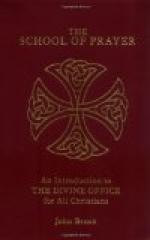In the first ages of the Church the Apostles and Martyrs only were commemorated in public prayers and, above all, in the Mass, perhaps, by a special prayer. Then, in time, followed the reading of a panegyric in their honour, and later still hymns and histories of martyrdom were added to the public recitation of the Office. Still later, there were added the feasts of the saints with an office resembling our simple office. Matins were entirely ferial, but had either a biography of the saint or a long extract from the Fathers added. The other hours were as in a Sunday office, save that these feasts had no Vesper matter.
In still later times, the Church added to the list of names on her saint roll, the names of saints who were honoured neither as Apostles nor as Martyrs. For these, special Masses, offices and feasts were established. St. Martin of Tours was the first confessor so honoured in the Western Church. For the more important feasts, an office of nine lessons was established and this came to be known as a semi-double office, and later such feasts were called doubles. Hence, before the thirteenth century, we find celebrations of simple feasts, of semi-doubles and of doubles. And Durandus, who wrote in the thirteenth century, tells us of the existence of doubles major and doubles minor. The Breviary of St. Pius V., published in 1568, gives three classes of doubles: doubles of the first class, doubles of the second class, and doubles per annum. But, in the revision by Clement VIII. the doubles per annum were again divided into doubles major and doubles minor. In the new Pian Breviary (1913) doubles are divided into Primary Doubles of the First Class, Secondary Doubles of the First Class; Primary Doubles of the Second Class, Secondary Doubles of the Second Class, Primary Doubles Major, Secondary Doubles Major. The list of feasts under each of these six headings may be seen in the Breviary.
Do double offices differ specifically from each other? No, the form is the same in all double offices. What then is the difference between doubles of different classes? The difference is chiefly in the preference which is given to them in cases of concurrence or occurrence of feasts of greater or of lesser rite.
The word “double” (duplex) is derived, some authors hold, from the ancient custom of reciting two offices or saying two Masses on the same day—one for the current feria and one for the feast (festa). Other authors say that the word is derived from the ancient practice of chanting twice or in repetition the complete responses and versicles. And, above all, the recitation of the full antiphons before and after each psalm, at Matins, Lauds and Vespers, was called “duplication,” and this name, it is said, was given to the office (double, duplex) in which the practice of duplication took place.




